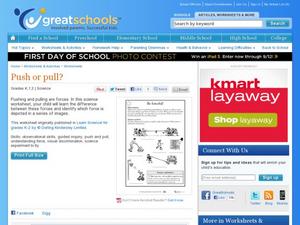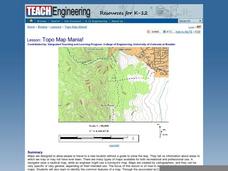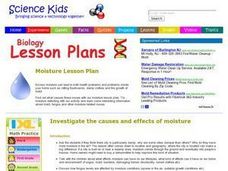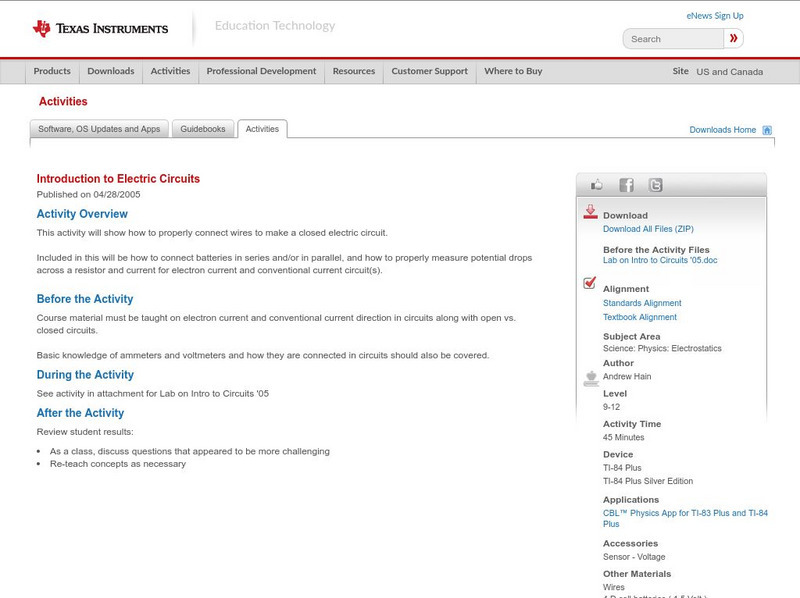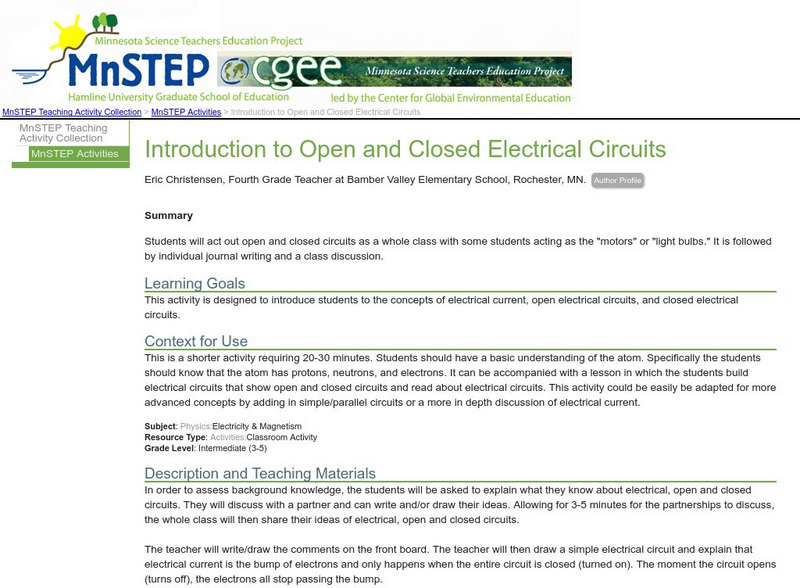Curated OER
A Guide (on the Side) to Physics
Students engage in a lesson plan that is concerned with the concepts related to the study of Physics. They participate in class discussion and list common misconceptions of Physics. Students write and discuss the problem of Science...
Curated OER
Be forceful!
Didn't some scientist develop rules about force and motion? Youngsters can experience physical science as they determine which picture shows the force of pushing or pulling. Tip: Ask learners if they can think of any unseen forces that...
Curated OER
Insulators and Conductors
Fourth graders experiment to discover which items are conductors and which items are insulators. In this insulators and conductors lesson plan, 4th graders experiment and create a T-Chart. Students are assessed on the...
Curated OER
A Salt and Battery
In this battery activity, students read about oxidation-reduction reactions and voltaic cells. They are given a diagram of an electrochemical cell and they answer four questions using the cell. They also identify the anode given two...
Curated OER
Ohm's Law, Watt's Law and Solving Formulas.
Young scholars, in groups, connect a 10 ohm resistor across their 1.5 volt battery, and take voltage readings every 5 minutes.
Curated OER
Ohm's Law
Students explore Ohm's Law. Following given instructions, students build a physical model of a conductor. They observe a relationship between the current, voltage and resistance in a conductor. After experiments, students explain the...
Curated OER
Making A Compass
This interesting science instructional activity is about the compass. Students make a compass out of a magnet, sewing needle, cork, and a glass dish. The instructional activity includes both a pre and post-test for the students to take,...
Curated OER
Topo Map Mania!
Seventh graders describe the major features of maps and compasses. They read a topographical map. They take a bearing using a compass. They practice using scales on a map.
Curated OER
TE Lesson: Navigating at the Speed of Satellites
Students study the basic concepts of the Global Positioning System and how it increases the accuracy of navigation. They examine trilateration and how the speed of light is used to calculate distances.
Curated OER
Base 3
Learners investigate this problem that aims to give a better idea of our decimal system by looking at a comparable system - the base 3 system. By seeing how base 3 numbers work students should have a better appreciation of base 10...
Curated OER
Moisture Lesson Plan
Students investigate the effects of moisture and dampness on homes, clothing, and mold growth. In this moisture lesson, students discuss which certain cities are damper than others based on location and geography. They talk about the...
Other
The Blobz Guide to Electric Circuits
An exciting interactive site of games, activities, information, and quizzes about electric circuits. You'll learn what makes circuits work, all about conductors and insulators, switches, changing circuits, and circuit diagrams. Learning...
Other
Tech Topics: Electricity: Circuits
What is a circuit? How does it work? The animated diagrams and accompanying text will make it easy to understand the concept of circuits!
Texas Instruments
Texas Instruments: Introduction to Electric Circuits
This activity will show how to properly connect wires to make a closed electric circuit. Included in this will be how to connect batteries in series and/or in parallel, and how to properly measure potential drops across a resistor and...
Science Education Resource Center at Carleton College
Serc: Lighting the Way: Electrical Circuits and Lamp Wiring
Through a series of self-guided activities, students will explore basic electrical circuits and then build a working model of a circuit through the process of wiring a lamp. They will understand the flow of electrons through a circuit,...
National Geographic
National Geographic: Building Circuits
In this lesson, students build series and parallel circuits and test their conductivity. Includes handouts with diagrams, and a vocabulary list with definitions.
Science Education Resource Center at Carleton College
Serc: Electric Circuits Guided Inquiry
An electrical circuit guided inquiry where middle schoolers investigate what an electric circuit is, the main parts of a circuit and the difference between series and parallel circuits. Students groups create a circuit using materials...
Physics Classroom
The Physics Classroom: Electric Circuits: Circuit Builder
Students manipulate this virtual electronic circuit board where they can add resistors, light bulbs, wires, and ammeters to build a circuit, explore Ohm's law, and compare and contrast series, parallel, and combination circuits. Three...
Science Education Resource Center at Carleton College
Serc: Investigate Electric Circuits Through Construction and Illustration
In this physics instructional activity 4th grade students investigate electrical circuits in greater depth than the FOSS unit used in a prior grade in school. Students become familiar with a computer simulation allowing them greater...
Science Education Resource Center at Carleton College
Serc: Introduction to Open and Closed Electrical Circuits
This activity introduces students to the concepts of electrical current and open and closed circuits. Students will act out open and closed circuits as a whole class with some students acting as the "motors" or "light bulbs."
TeachEngineering
Teach Engineering: Saltwater Circuit
Students build a saltwater circuit, which is an electrical circuit that uses saltwater as part of the circuit. Students investigate the conductivity of saltwater, and develop an understanding of how the amount of salt in a solution...
TeachEngineering
Teach Engineering: From Sunlight to Electric Current
The lesson will first explore the concept of current in electrical circuits. Current will be defined as the flow of electrons. Photovoltaic (PV) cell properties will then be introduced. This will lead to the principle of "Conservation of...
American Geosciences Institute
American Geosciences Institute: Earth Science Week: Mineral Electrical Conductivity
The purpose of this activity is to test the conductivity of various minerals with a simple electrical circuit and draw conclusions about which ones would be used in electronics.


